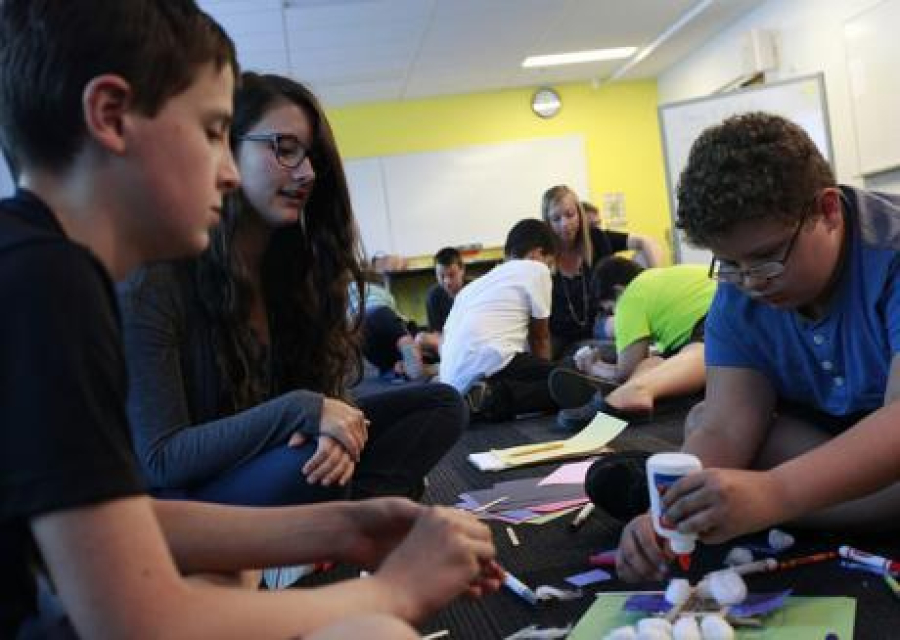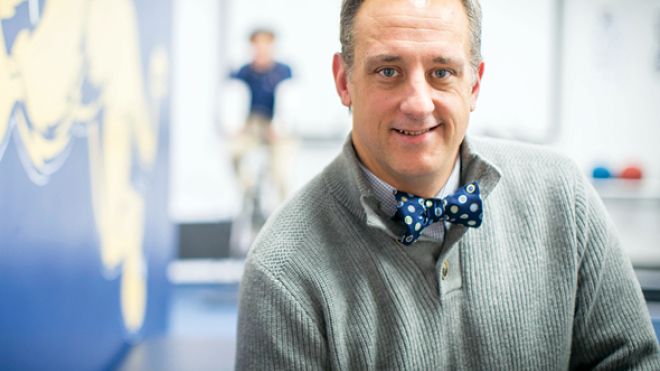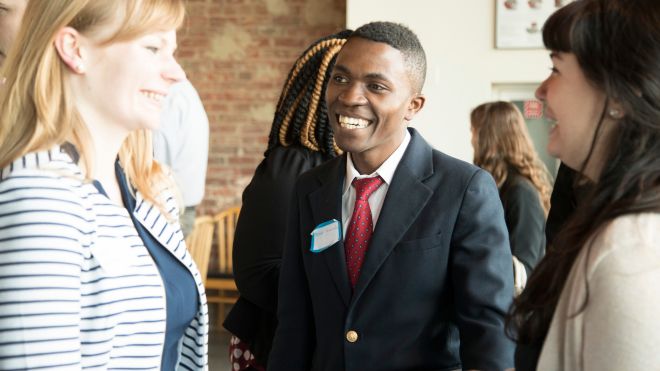
For parents, this is a story of hope.
For educators of special needs children, this is a story about support.
And for researchers who study the neurological disorder known as autism, this is a story about breakthroughs.
Dr. Leo Kanner, a psychiatrist at Johns Hopkins University, first identified autism in 1943. He used the term to describe the withdrawn behavior of children he studied. Before that, the disorder didn’t exist as far as clinicians were concerned. Surely, there were individuals with autism. But they were discounted and labeled as awkward, odd or eccentric.
Seventy years later, there is no known cure for the disorder. But children, who previously would have been overlooked, now receive the attention and treatment they need to manage the disorder at the Institute for Autism Research (IAR) at Canisius University.
“I’m so appreciative of the work they do,” says Renee Marciniak, whose daughter, Corrine is diagnosed with autism. “They understand the kids and they’re making real differences in their lives.”
Prior to coming to the IAR, Corrine avoided social situations. She preferred to stand by herself before school each morning rather than gather with kids her age. When other children tried to initiate conversations, “she didn’t respond or follow through,” remembers Marciniak. Corrine similarly struggled to express her emotions. She appeared to lack empathy for others. “She couldn’t tell when someone was happy or sad, appreciative or mad,” adds Marciniak.
Corrine exhibits many of the hallmarks of autism. There are others, including narrow interests and obsessive routines. As children grow, their impairments often become more complicated, both behaviorally and emotionally.
“The core symptom is the social disability but then depression, anxiety and a host of other emotional and behavioral difficulties layer on top of it,” explains Marcus L. Thomeer, PhD, who co-founded and co-directs the IAR with colleague Christopher Lopata, PsyD.
The many manifestations of autism are collectively known as autism spectrum disorders (ASDs). The severity of the symptoms, from mildly impaired to severely disabled, determines where a child falls on the spectrum.
The Centers for Disease Control and Prevention estimate[i1] that nearly one in 88 children fall somewhere on the autism spectrum. This marks a 23 percent increase in just two years and a 78 percent increase since 2000. The rise is attributed to an expanded definition of the disorder, greater public awareness of it, and an improved ability among physicians to distinguish it from other conditions. The increase is mobilizing researchers to figure out how best to treat autism.
“A largely ignored fact is that this is a chronic disorder,” says Susan Williams White, PhD. An assistant professor of psychology at Virginia Tech, White is the author of Social Skills Training for Children with Asperger Syndrome and High Functioning Autism. She closely follows the work of the IAR. “You don’t age out of the diagnosis. You treat it for a lifetime with the idea being that the individual can live a better quality of life.”
The Institute for Autism Research offers the best chance at this, for the Marciniak family and others like them.
Established in 2009, the IAR is dedicated to better understanding autism and enhancing the lives of affected children. The institute’s work has led to the development of several new and successful treatment programs that garnered the attention of the clinical and research communities and the national media. Most renowned is summerMAX, which was one of the first comprehensive treatment programs proven effective for high-functioning children with autism.
“The treatment program developed by Chris and Marcus and their colleagues at the institute gets at the core symptoms of ASD – the social, behavioral and emotional,” says White, who invited Lopata and Thomeer to co-author a chapter in her newest book CBT for Children and Adolescents with High-Functioning Autism Spectrum Disorders. “This is what makes their work so universally appealing to families, educators and researchers.”
In many ways, summerMAX is similar to a summer camp: Children participate in group activities, games and field trips. But summerMax is actually a treatment research program. Lopata and Thomeer develop strategies to treat ASD symptoms. These strategies are incorporated into the program’s activities. Institute researchers, many of whom are undergraduate and graduate students, implement the strategies and then assess the impact to determine which ones result in the greatest gains among children.
According to results from two randomized clinical trials, children who participate in summerMAX consistently show vast improvements in their understanding of what social skills to use in a range of situations. Children are also more likely to engage in social interactions compared to those who do not receive treatment, and maintain their social gains after completing the five-week program.
Family members of children with ASD, however, say the greatest outcomes are watching their sons, daughters and siblings grow into loving, understanding and social individuals.
“Nathan used to want to stay in his room and play by himself,” recalls Dawn Helms whose son is a summerMAX alumnus. “He’s so much more confident. He now takes an interest in what we’re doing as a family. He starts conversations at dinner rather than waiting to be asked a question. He’s more empathetic and more able to read emotional cues.” She pauses. “When I hug Nathan now, he knows it’s because I’m happy.”
The institute attributes its treatment success to the comprehensive approach it takes to the complex disorder.
The IAR’s treatment strategy combines psychology with education to teach children appropriate social and communication skills and behaviors, and decrease their autism symptoms. Each treatment component targets a different impairment but the methodology is always the same, in that it teaches specific skills and provides children with multiple opportunities to practice those skills through activities that are fun in nature. It’s a cumulative process, which begins with children learning very rudimentary social skills, such as how to start a conversation, maintain a conversation and end it. Each new social skill children learn builds upon the one before it.
“A typically developing child often learns how to listen, ask a question or have a conversation just by living, growing up and maturing. But children on the autism spectrum do not learn implicitly,” says Lopata. Instead, “The most meaningful and sustainable outcomes occur when children are taught, at a cognitive level, what the behavioral, physiological and emotional responses are to very common social situations.”
The IAR’s findings are now the foundation for its latest research, to test the effectiveness of its recently developed treatment program in school settings. A historic $3.4 million research grant from the U. S. Department of Education Institute of Education Services will support the four-year study. Preliminary research on the school program, conducted at Dodge Elementary in Williamsville, NY showed much promise.
“So much of ASD research focuses on determining its cause and early detection, for good reason,” says Principal Lynn Fritzinger. “Helping those same children succeed academically and socially once they enter school, however, is an area that is largely overlooked.”
Schools can be particularly difficult environments for children with ASD to navigate. Not only do they need to learn their academics, “they also need to adapt to the classroom environment and all the social, emotional and communication challenges intrinsic to it,” explains Kathy Zwierzchowski, a speech pathologist who leads Dodge Elementary’s Diverse Resources Team.
These challenges are compounded by budget-strapped school districts and time-crunched teachers, which severely limit treatment consistency or intensity. At best, some schools treat one, maybe two of a child’s symptoms. Rarely are they able to treat all ASD symptoms.
Still, educators, parents and research professionals agree that schools should be the primary avenue for children with ASDs to receive treatment. The Institute for Autism Research developed the school model to do just that.
SchoolMAX applies the IAR’s treatment strategies in the classroom. Similar to summerMAX, each strategy targets a different impairment and the methodology includes instruction, modeling and role play. Each time a student carries out a learned skill, the student receives immediate feedback to strengthen learning and the skill used is recorded on an individual daily note, or IDN.
“The IDNs enable us to measure the progress of each child, which is something we never did before and therefore, we never knew for sure if we were having an impact on the children,” says Zwierzchowski. “Now we know, specifically, when it’s time to raise the bar, revisit certain skill sets or introduce new ones.”
The IDNs also paint a clear picture for the institute as to which treatment strategies are working in the classroom and which need to be modified. Initial pilot studies indicated that schoolMAX resulted in “significant gains for children on the spectrum,” says Thomeer.
Children demonstrated increased knowledge and use of social skills, a greater ability to read emotions in the facial expressions in others, and a substantial decrease in the severity of their ASD symptoms. The pilot program earned high marks from educators as well.
“We felt we had a very good foundation already in place at Dodge, prior to our relationship with the IAR,” says Principal Fritzinger. “But the institute’s program put structure to what we do and in a sustainable yet flexible enough way, so that the focus is always on consistency, intensity and accountability – everything we need to really help our children and their families.”
Families, in fact, are as integral to the success of the IAR’s social development treatment as educators. Parents participate in education sessions and work with their children at home to reinforce skills. They also monitor their children’s progress on the IDNs, which are sent home every day. The families meet regularly with school educators or IAR instructors to review their children’s progress. It’s also a time when families can ask questions or discuss concerns.
“I really believe the success Nathan has had is due, in large part, to the fact that everyone is on the same page,” says Dawn Helms. “The treatment strategies being used at school are the same strategies used in the summer program and the same strategies we use at home.”
The large group family meetings serve an added purpose.
“We’ve made some nice connections with other parents of children with ASDs,” adds Marciniak. “To be able to share stories and talk about your child’s progress with one another just brings an additional element of support to the whole program.”
Treating autism is very much a team effort. But a diagnosis no longer guarantees a difficult life. The work at the Institute for Autism Research has proven that with enough investment and hard work, children with ASD can learn to overcome their impairments so that one day, they may grow up to live ordinary – and perhaps even extraordinary – lives.
“We need to give these kids an opportunity to attend school, go to college, to find meaningful work as adults, to have a family and ultimately not be so isolated from society,” says Thomeer. “All our efforts are undertaken with this in mind – to improve the lives of children with autism.”
All indications are that the Institute for Autism Research is making significant progress toward that goal.
WEB EXTRA: Click here to read more about how support from local and national agencies is helping the Institute for Autism Research in its efforts to translate the autism puzzle into treatment.



